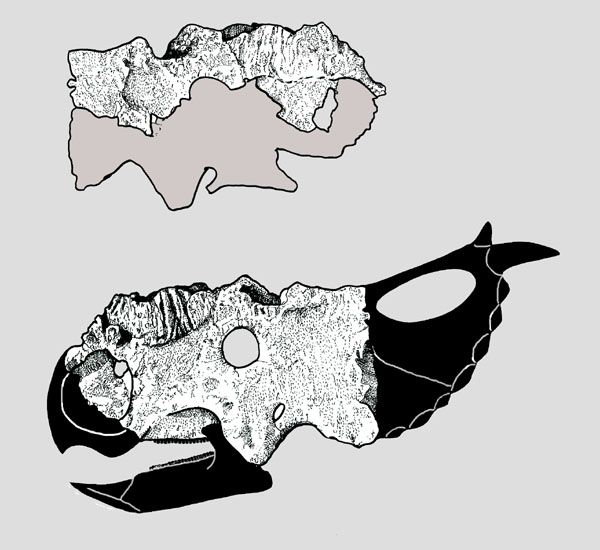
Species: canadensis STERNBERG, 1950
Etymology: In reference to the country of Canada where the specimen was found.
Holotype: NMC 8867
Locality: Near centrae of SW 1/4, sec. 24, T14, R23, W 4th mer, on the north side of the Little Bow River Valley, near Carmangay, Lethbridge County, Alberta Province, Canada.
Horizon: Horseshoe Canyon Formation, Edmonton Group.
Biostratigraphy:
Age: Edmontonian age, lower Maastrichtian Stage, Upper Senonian subepoch, Upper Gulf Epoch, Late Cretaceous.
Material: Fragmentary skull lacking rostrum and incomplete posteriorly

Paratype: NMC 8866: Anterior part of skull with right lower jaw but lacking beak.
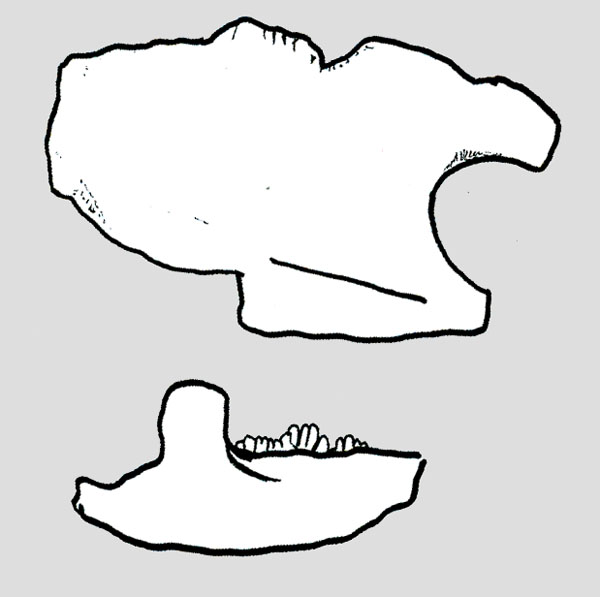
Referred material:
LANGSTON, 1967
Locality: Southwest corner of legal subdivision 6, sec. 10, tp 30, range 21, west side of the 4th meridian, close to the mouth of a dry lateral tributary on the east side of Red Deer River, 1.5 miles south of the Munson Ferry, near Bleriort Ferry, Drumheller, Wheatland County, Alberta Province, Canada.
Horizon: Horseshoe Canyon Formation, Edmonton Group.
Biostratigraphy:
Age: Edmontonian age, lower Maastrichtian Stage, Upper Senonian subepoch, Upper Gulf Epoch, Late Cretaceous.
Material:
Drumheller and District Museum Society Museum: Nearly complete skull lacking frill and dentary.
Note: Both quadrates of this specimen were found. (RYAN, BELL & EBERTH, 1995).
Note: More of the skeleton was found by the RTMP (TANKE, 2006). RTMP93.29.4: Articular ends of both quadrates, squamosal fragments, and part of a distal jugal with about 65% of an attached epijugal.
RTMP 98.25.90: Femur.
Note: With a tyrannosaur tooth embedded?RTMP 84.25.32: Cervical vertebra.
Number: Not given: Fragmentary skull pieces and skeletal remains.
LANGSTON, 1976
Locality: Scabby Butte Site 1, about 100 feet north of the south linage SE 1/4, SE 1/4, Sec. 18, Lethbridge County, Southern Alberta Province, Canada.
Horizon: St. Mary River Formation.
Biostratigraphy:
Age: Edmontonian age, Upper Campanian Stage- Lower Maastrichtian Stage, Senonian subepoch, Upper Gulf Epoch, Late Cretaceous.
Material:
NMC 8860: Nasofrontal boss, part of rostrum, and fragments possibly composite.
Locality: Scabby Butte Site 2, on the westerly escarpment in SE 1/4, SE 1/4, Sec. 18, Lethbridge County, Southern Alberta Province, Canada.Horizon: St. Mary River Formation.
Biostratigraphy:
Age: Edmontonian age, Upper Campanian Stage- Lower Maastrichtian Stage, Senonian subepoch, Upper Gulf Epoch, Late Cretaceous.
Material:
NMC 9485: Skull, lacking cheek bones and frill.
NMC 10663: Skull, lacking cheek bones, frill, and side of face.
NMC 10664: Right lachrymal.
NMC 10646: Left quadratojugal and part of attached jugal.
NMC 9610: Left quadrate.
NMC 9594: Incomplete left squamosal.
NMC 10665: Skull fragments of uncertain position.
NMC 10666: Skull fragments of uncertain position.
NMC 10667: Tooth.
NMC 10643: Right dentary.
NMC 10629: Left surangular.
NMC 9602: Fragment of frill.
A) NMC 8863; B) NMC 10644.
NMC 10644: Portion of frill.
NMC 8863: Frill spike.
NMC 9600, 10630-10633: Vertebrae.
NMC 9719, 10635-10639: Dorsal ribs.
NMC 9721: Right scapula.
NMC 9722: Left scapula.
NMC 10640: Right humerus.
NMC 10641: Right femur.
NMC 9583: Right tibia.
NMC 10642: Distal end of fibula.
Locality: Scabby Butte Site 6, Lethbridge County, Southern Alberta Province, Canada.
Horizon: St. Mary River Formation.
Biostratigraphy:
Age: Edmontonian age, Upper Campanian Stage- Lower Maastrichtian Stage, Senonian subepoch, Upper Gulf Epoch, Late Cretaceous.
Material:
NMC 10645: Fragmentary skull and lower jaw.
NMC 21863, 10669: Fragmentary cranial bosses and other skull parts.
TANKE, 2006
Locality: Rosdale, Alberta Province, Canada.
Horizon: Lower Horseshoe Canyon Formation, Edmonton Group.
Biostratigraphy:
Age: Edmontonian age, lower Maastrichtian Stage, Upper Senonian subepoch, Upper Gulf Epoch, Late Cretaceous.
Material:
In situ: An adult and badly shattred skull.
Locality: Cambria, Alberta Province, Canada.
Horizon: Lower Horseshoe Canyon Formation, Edmonton Group.
Biostratigraphy:
Age: Edmontonian age, lower Maastrichtian Stage, Upper Senonian subepoch, Upper Gulf Epoch, Late Cretaceous.
Material:
RTMP 1999.63.12: Part of a nasal boss.
Note: The rest of the specimen was left in situ.
TANKE, 2007
Locality: Scabby Butte Site 1, Lethbridge County, Southern Alberta Province, Canada.
Horizon: St. Mary River Formation.
Biostratigraphy:
Age: Edmontonian age, Upper Campanian Stage- Lower Maastrichtian Stage, Senonian subepoch, Upper Gulf Epoch, Late Cretaceous.
Material:
RTMP 82.51.1: Posterior half an adult nasal boss.
_____________________________________________________________________________________
Species: lakustai CURRIE, LANGSTON & TANKE, 2008
Etymology: In honor of Al Lakusta, who discovered and reported the bone bed.
Holotype: RTMP 1986.55.258
Locality: Pachyrhinosaurus bone bed, East bank of Pipestone Creek (10 meters above water level, 19 km southwest of Grande Prairie, West of Edmonton, Grande Prairie County, Alberta Province, Canada.
Horizon: Wapiti Formation.
Biostratigraphy:
Age: Late Campanian Stage, Upper Senonian subepoch, Upper Gulf Epoch, Late Cretaceous.
Material: Fragmentary skull. "Cybill"
Note: From a bonebed. Some skulls have a concave boss others a convex and a
juvenile with both.
Referred material:
RTMP 1988.55.918: Fragmentary skull.
RTMP 1985.112.110, 1989.55.53, 1989.55.191, 1989.55.728, 1989.55.958, 1989.55.1240: Right nasals.
SAMPSON, RYAN & TANKE, 1997
RTMP 88.55.80: Sub adult nasal horn.
TANKE & FARKE, 2003, 2006
RTMP 1989.55.1234: Skull with squamosals, but missing palate, distal jugals, quadrates, quadratojuals, and parietal. "Tara".
Note: Palaeopathology, left side of skull has a large circular penetrating lesion, 4 POLs, left squamosal, resorption zone, left squamosal, raised protuberance, left maxilla.TANKE, 2004
RTMP 2001.1.111: Partial skull.
GPRC/RH/03.06.03.01.02.015: Partial skull.
My original illusration of the skull.
Pachyrhinosaurus bone bed I drew for Darren Tanke decades ago.
TANKE, 2007
RTMP 1985.112.1: Skull roof, orbital and nasal boss.
RTMP 1986.55.29: Dorsal rib.
RTMP 1986.55.111: Fragmentary skull.
Note: Has a smool, flattened lobe of bone on the antero-ventrla edge of the left squamosal, possible from an injury.
RTMP 87.55.285: Fragmentary skulls.
RTMP 1986.55.206: Nasal boss.
RTMP 87.55.141: Posterior section of frill.
RTMP 1987.55.156: Good skull, missing rostrum, palate, distal jugals, quadrats, quadratojuals, distal exoccipitals, parietal, and both squamosals.
RTMP 1987.55.196: Skull roof.
RTMP 1987.55.199: Snout region, rostrum, right premaxilla, anterior half of nasal boss, ventro-posterior left premaxilla missing. "Stephine".
RTMP 87.55.285: Complete front half of skull, anterior orbit margin to rostrum. "Bertha".
RTMP 87.55.304: Dorso-ventrally crushed skull. "Ashley".
RTMP 87.55.320: Rostrum back to both postorbitals to maxillae or braincase, distal jugal missing.
RTMP 1989.55.188: Skull, left side with complete jugal, squamosal, exoccipital. Right side missing distal exoccipital, jugal, squamosal, both quadrato and quadratojuals missing. "Louise".
Note: Pathology, the right tip of the rostrum has been lost on both sides.RTMP 1989.55.427: Skull roof with nasals and orbital boss. "Zemona".
RTMP 2002.29.1: Nearly complete skull “Patty”.
TANKE & ROTHSCHILD, 2010
RMTP 86.55.304: Jugal with relatively smooth-floored cicular depressions, pathologic?
RTMP 87.55.101: Quadrate with three anomalies, pathologic.
RTMP 89.55.1072: Quadrate with two pathologies; a circular depression on the articulating surface and has a crack that runs diagonally between the two distal condyles.
RTMP 89.55.883: Parietal bar of an adult that is pathologic.
RMTP 88.55.90, 89.55.125: Two subadult parietals with pathologies.
RTMP 1987.55.258: Fragment of a parietal.
RTMP 1987.55.232: Fragment of a parietal.
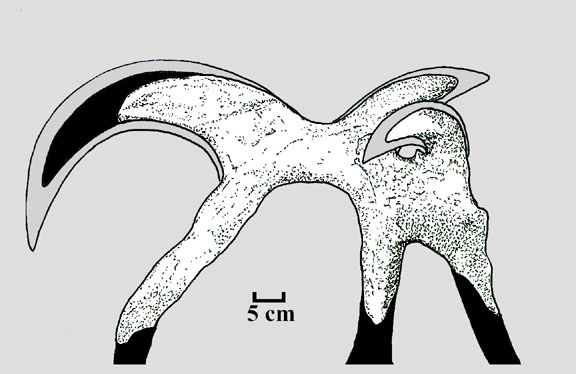
RTMP 1987.55.210: Parietal lacks left p3 frill spike; it suffered massive fracture injuries and unusual post-trauma healing.
Note: Pathologic (I discovered this specimen, :) )
RTMP 89.55.1085: Parietal has two pathologic P3 frilll spike.
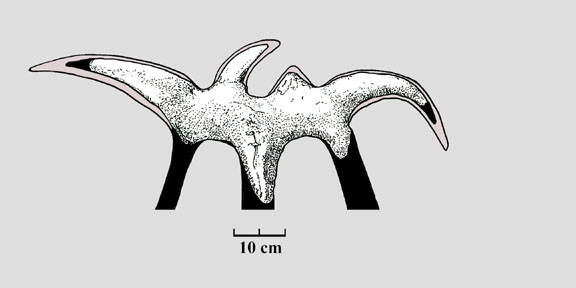
RTMP 89.55.1503: Possible pathologic frill with irregular right P3 frill spike.
RTMP 1989.55.1241: Parietal.
RTMP 1987.55.164: Parietal
RTMP 1986.55.113: Parietal
RTMP 1989.55.1144: Parietal.
RTMP 1986.55.239: Parietal.
RTMP 1986.55.261: Parietal.
RTMP 1988.55.46: Parietal
RTMP 1986.55.48: Nasal of a baby.
RTMP 1988.55.80: Nasal.
RTMP 1987.55.161: Nasal.
RTMP 1989.55.256: Nasal.
RTMP 1989.55.1342: Nasal.
RTMP 1986.55.193: Lateral rami of parietal.
RTMP 1983.55.15: Lateral rami of parietal.
RTMP 1989.55.130: Lateral rami of parietal.
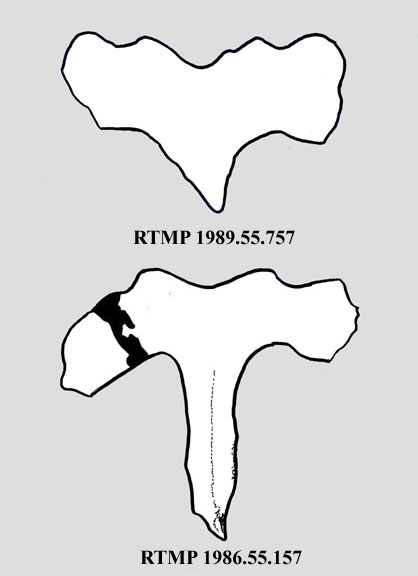
RTMP 1986.55.157: Fragmentary parietal.
Note: "Monoclonius"-like.RTMP 1989.55.399: Fragmentary parietal.
Note: "Monoclonius"-like.RTMP 1987.55.258: Fragmentary parietal.
Note: "Monoclonius"-like.RTMP 1989.55.757: Fragmentary parietal.
Note: "Monoclonius"-like.RTMP 89.55.978: Pathologic isolated cervical neural arch wiht the right prezygapophysis misshapen and several concentric folds of ridges occuring external to the zygapophyses on the dorsal side of the transverse process. Disease-related.
RMTP 88.55.52: Pathologic a reduced and malformed zygapophysis, but also has deep pitting on the centrum endplate. Disease-related.
RTMP 85.112.52, 89.55.719: Broken and healed ribs.
RTMP 89.55.464: Juvenile left dorsal rib.
RTMP 88.55.191, 89.55.389, 89.55.1481: Ribs with callus.
RTMP 87.55.90: Rib with pseudoarthrosis.
RTMP 89.55.205, 89.55.801: Non-infectious breaks imperfectly healed and forming pseudoarthroses.
RTMP 89.55.363: Proximal caudal with osteopathy.
RTMP 89.55.287: Mid-caudal wiht osteopathy.
RTMP 87.55.102: 4 fused caudal vertebrae.
RTMP 87.55.190: Left scapula with two smooth, low rounded co-joinged calluses on the thickened ridge (scapualr spine) that bisects the scapualr blade.
RTMP 85.112.70: Mild stress fracture on a phalange.
RTMP 67.19.85: Phalange with severe form of a stress fracture.
_____________________________________________________________________________________
Species: perotorum FIORILLO & TYKOSKI, 2012
Etymology: In recongnition of members of the Perot family (Margot and H. Ross
Perot and thier children), who demonstrated a long history of supporting
science and science education for the public.
= Species: Nova FIORILLO & GANGLOFF, 2003
Holotype: DMNH 21200
Locality: Kikak-Tegoseak Bonebed, Colville River, North Slope, Alaska.
Note: Exact coordinates on file at the Museum of nature and Science, Dallas, for qualified researchers.
Horizon: Prince Creek Formation.
Biostratigraphy:
Age: Campanian-Maastrichtian Stage, Upper Senonian subepoch, Upper Gulf Epoch, Late Cretaceous.
Material: Posterior part fo parietal including partial median bar, posterior median emargination, and autapomorphic anterior-facing horns.
Paratypes:
FIORILLO, McCARTHY, FLAIG, BRANDLEN, NORTON, ZIPPI, JACOBS & GANGLOFF, 2010
DMNH 22558: Fragmentary skull.
Note: Paleopathology on the skull (lesion on the boss), FIORILLO Y TYKOSKI, 2022.
DMNH 21201: A short segament of right parietal transverse bar bearing an anterior
rim horn.
Referred material:
FIORILLO & TYKOSKI, 2013
DMNH 21460: Fragmentary nasal horn of a juvenle.
Pachyrhinosaurus perotorum (modified from FIORILLO & TYKOSKI, 2013), DMNH 21460.
FIORILLO & TYKOSKI, 2022
DMNH 22378: Incomplete mid to distal cuadla vertebra.
Note: Pathologic.
DMNH 25551: Nerly complete metacapral V.
Note: Pathologic.
DMNH 25676: Right tibia and fused distal end of right fibula.
Note; Pathologic.
TYKOSKI, FIORILLO & CHIBA, 2019
DMNH 22194: A partial braincase.
DMNH 24803: A partial skull lacking much of the left side of the skull ane the parietal-squamosal frill.
Note: Paleopathology on the skull (lesion on the boss), FIORILLO Y TYKOSKI, 2022.
DMNH 24252: A partial skull consisting mainly of the dorsal surface of the skull from near the rostrum tip to the supraorbital buttress.
Note: Paleopathology on the skull (lesion on the boss), FIORILLO Y TYKOSKI, 2022.
DMNH 24335: A partial skull consisting of a transversely broken section throught the rostrum between the orbits and the naris.
DMNH 22196: A large, horn-shaped parietal process.
DMNH 21689: A section of transverse parietal bar with yet-to-be-identified processes.
DMNH 24182: A partial transverse parietal bar including a large epiparietal 3 horn and an associated epiparietal 2 horn.
DMNH 21206: A partial parietl including an epiparietal 3 horn, section of transverse parietal bar, and lateral ramus.
FIORILLO & TYKOSKI, 2022
Locality: Clam Gultch, Colville River, North Slope, Alaska.
Note: Exact coordinates on file at the Museum of nature and Science, Dallas, for qualified researchers.
Horizon: Prince Creek Formation.
Biostratigraphy:
Age: Campanian-Maastrichtian Stage, Upper Senonian subepoch, Upper Gulf Epoch, Late Cretaceous.
Material:
DMNH 24618: Articular end of a right quadrate.
Note: Paleopathologic.
DMNH 21452: Pathologic bone.